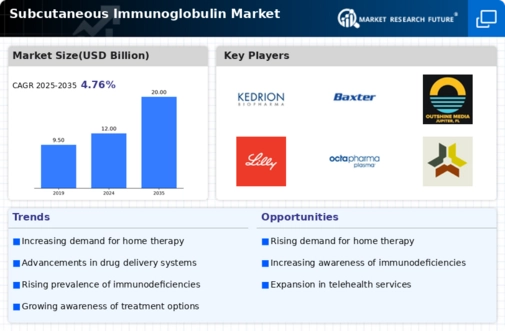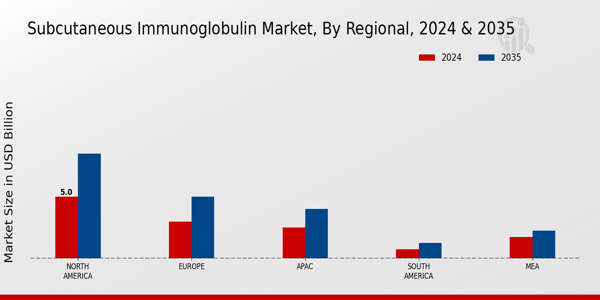Market Growth Projections
Rising Demand for Home-Based Therapies
The shift towards home-based therapies is transforming the landscape of the Global Subcutaneous Immunoglobulin Market Industry. Patients increasingly prefer to receive treatments in the comfort of their homes, which aligns with the growing trend of personalized healthcare. Subcutaneous immunoglobulin therapies are particularly well-suited for home administration, allowing for greater flexibility and convenience. This demand is likely to drive market growth, as healthcare systems adapt to accommodate patient preferences. The market's expansion could be further supported by advancements in telehealth and remote monitoring technologies, which facilitate home-based care and enhance patient engagement.
Growing Awareness and Education Initiatives
Educational initiatives aimed at healthcare professionals and patients are fostering greater awareness of subcutaneous immunoglobulin therapies. As knowledge about the benefits and applications of these treatments spreads, more patients are likely to be diagnosed and treated effectively. The Global Subcutaneous Immunoglobulin Market Industry stands to benefit from these efforts, as increased awareness can lead to higher adoption rates of immunoglobulin therapies. This trend is expected to support a compound annual growth rate (CAGR) of 4.76% from 2025 to 2035, reflecting the positive impact of education on market dynamics. Enhanced understanding of treatment options may also empower patients to seek timely interventions.
Regulatory Support and Reimbursement Policies
Supportive regulatory frameworks and favorable reimbursement policies are crucial drivers for the Global Subcutaneous Immunoglobulin Market Industry. Governments and health authorities are increasingly recognizing the importance of immunoglobulin therapies, leading to improved access and affordability for patients. These policies can significantly influence market dynamics, as favorable reimbursement rates encourage healthcare providers to prescribe subcutaneous immunoglobulin therapies. As the market evolves, continued regulatory support is expected to facilitate growth, ensuring that patients have access to necessary treatments. This environment may contribute to the market's anticipated growth trajectory, with projections indicating a robust future.
Increasing Prevalence of Immunodeficiency Disorders
The rising incidence of immunodeficiency disorders globally drives demand for subcutaneous immunoglobulin therapies. Conditions such as primary immunodeficiency diseases and secondary immunodeficiencies are becoming more prevalent, necessitating effective treatment options. The Global Subcutaneous Immunoglobulin Market Industry is expected to witness substantial growth as healthcare providers increasingly adopt these therapies to manage patient care. In 2024, the market is projected to reach 12.0 USD Billion, reflecting the urgent need for innovative treatment solutions. As awareness of these disorders expands, more patients are likely to seek subcutaneous immunoglobulin therapies, further propelling market growth.
Technological Advancements in Administration Techniques
Innovations in administration techniques for subcutaneous immunoglobulin are enhancing patient compliance and treatment outcomes. Devices such as infusion pumps and auto-injectors are simplifying the administration process, making it more accessible for patients. This trend is particularly relevant in the Global Subcutaneous Immunoglobulin Market Industry, where ease of use can significantly impact patient adherence to therapy. As these technologies evolve, they are expected to contribute to the market's expansion, with projections indicating a growth trajectory that could see the market reach 20 USD Billion by 2035. Enhanced delivery methods may also lead to increased patient satisfaction and improved health outcomes.














